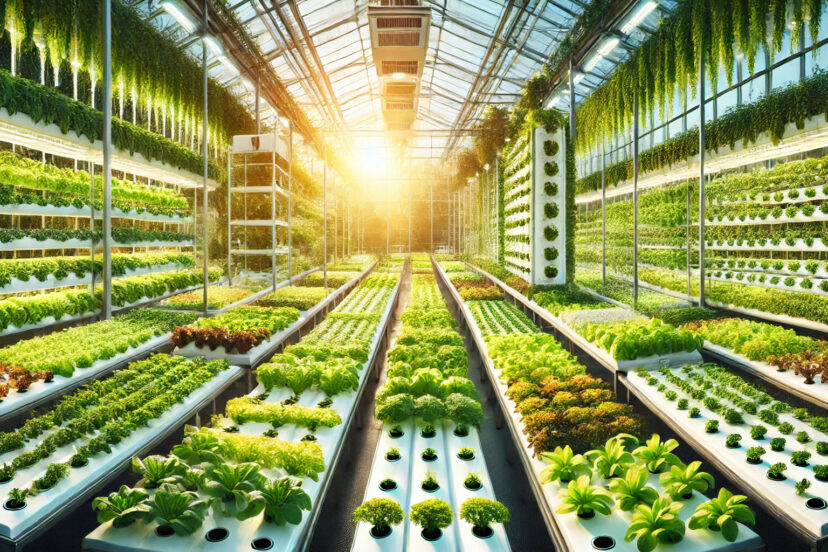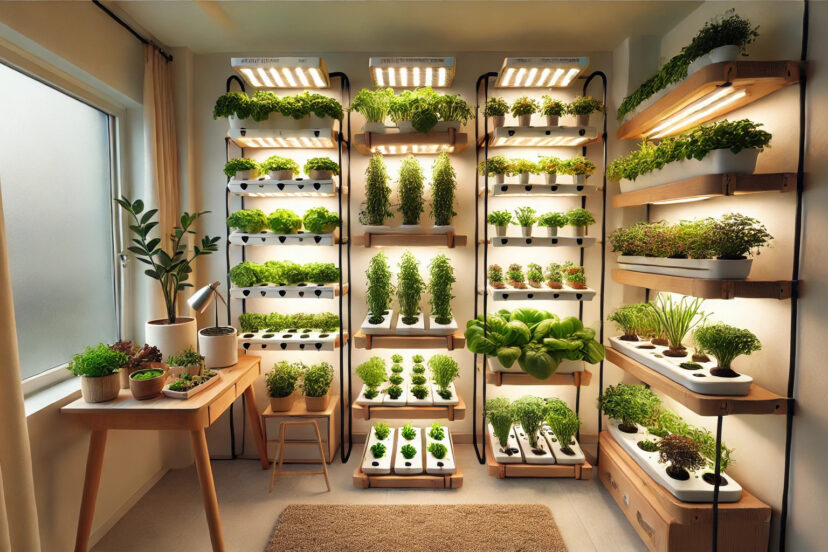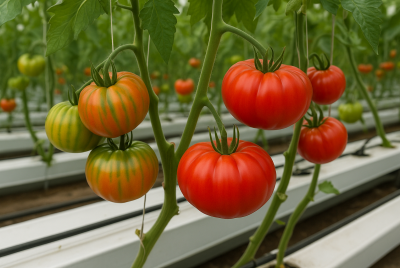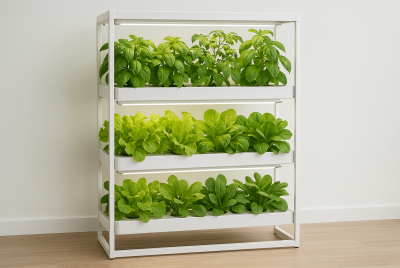Hydroponic Garden: A Modern Approach to Growing Plants
We may earn a commission for purchases made using our links. Please see our disclosure for more details.
Hey there, fellow greenskeeper! Would you agree that gardening relieves stress? But let’s face it… not everyone has enough space for a garden. Well, I have good news for you! You can build a hydroponic garden! Imagine growing your own herbs, plants, and favorite veggies at home. That’s amazing! Let’s explore the world of hydroponic gardening and see how they transform your small space into a lovely, organic garden.
What Is Hydroponic Gardening?
From the word itself, hydro means water. Hydroponics grow plants using water instead of soil. I know what you’re thinking… is that even possible? Uh-huh, it is possible to grow plants without soil. In hydroponics, plants are grown in a nutrient-rich water solution. This water solution has all the minerals they need directly to their roots. Crops also grow faster here compared to soil. A real game-changer, right?
Hydroponic gardening is grounded in robust scientific research, making it a highly efficient method for growing plants without soil. For those looking to delve deeper, the article “Hydroponics: A Practical Guide for the Soilless Grower” from the National Center for Biotechnology Information offers an in-depth exploration of various hydroponic techniques, demonstrating how these systems optimize plant growth by providing direct access to nutrient-rich water. Additionally, ScienceDirect’s resource on “Hydroponics” provides a comprehensive overview of the field, covering everything from basic principles to advanced applications, and highlights the ongoing innovations that make hydroponics a key component of modern agriculture.

Why Choose Hydroponic Gardening?
If you want to get rid of pesticides, then hydroponics is your best choice. Plus, plants grow incredibly fast with this method. 25% to 30% faster than soil-grown plants. Cool!!! For example, growing lettuce only takes about four to six weeks. And they’re organic!
Types of Hydroponic Systems
1. Deep Water Culture (DWC)
DWC might sound confusing but this system is one of the simplest ways to grow plants hydroponically. Perfect for beginners! In DWC, plants are suspended in a nutrient-rich water solution, with their roots fully submerged. An air pump provides oxygen to the roots, preventing them from drowning.
2. Nutrient Film Technique (NFT)
NFT is a bit more advanced and is commonly used in commercial hydroponics. When I first built my home garden, I jumped right into NFT because I wanted to grow some lettuce and sell it to my neighbors. Now this method doesn’t fully submerge the roots to the water. Only a small stream of nutrient solution water flows over the roots of the plants, which are supported by a sloped channel. This system is suitable for growing leafy greens.
3. Ebb and Flow (Flood and Drain)
Next on our list is the Ebb and Flow. This system uses a water pump to regularly flood your plant’s roots with nutrient solution then drain it away. From time to time, the roots are exposed to air so they can “breathe” before the next flood of nutrients.
4. Drip System
A drip system also utilizes a water pump to feed your plants with nutrient solutions. It delivers a slow and steady drip to the base of each plant. With this system, you can control the amount of solution each plant receives to ensure your plants get exactly what they need.
5. Aeroponics
Aeroponics is at another level here… In aeroponics, plants are suspended in the air while their roots are misted with a nutrient solution. Think of it as growing plants in zero gravity!
What Can You Grow in a Hydroponic Garden?
You can grow almost anything with a hydroponic garden! However, some plants are better suited to hydroponic systems than others. Let’s break it down, folks:
1. Leafy Greens
Do you love salad? I’m obsessed with fresh from the garden Caesar Salad! Lettuce, spinach, kale, and other leafy greens are perfect for hydroponic gardening. They have shallow roots and grow quickly, making them ideal for beginners. Imagine making a salad fresh from your garage… that’s super nice!
2. Herbs
Great news for cooking moms! Basil, mint, cilantro, and parsley are just a few of the herbs that flourish in hydroponic gardens. Imagine having fresh herbs at your fingertips year-round! Now you can cook more delicious meals without worrying where to grab some herbs.
3. Tomatoes
Another crop you can grow is tomatoes. I won’t lie but it’s a bit more challenging. You need more space and support for this one. But if you have tons of patience and a green thumb, you can enjoy a delicious, vine-ripened tomato.
4. Strawberries
Strawberries thrive in hydroponic systems, especially in vertical setups. They grow fast and produce fruit quickly, making them a sweet addition to your indoor garden. I’m gonna try planting strawberries for my next project 😉
5. Peppers
Who loves some pepper? Like tomatoes, peppers need a bit more care and space, but they’re perfectly suited to hydroponics. Bell peppers, jalapeños, and even more exotic varieties can be grown indoors with the right conditions.
Setting Up Your Hydroponic Garden
1. Choose Your System
The first step in your hydroponic garden journey is choosing which system to use. Are you a beginner? Or you have tried hydroponics before? If you’re new, go for Deep Water Culture. It’s the best place to start. If you’re adventurous like me, go to the next level and try NFT or Aeroponics.
2. Gather Your Materials
Of course, you need some materials to start with. Some stuff you need is a grow tray or reservoir, a water pump, an air pump, and a nutrient solution. You can also add a grow light if you don’t have access to natural light. Lastly, you’ll need a growing medium (rock wool, clay pellets, or coconut coir) to support your plants.
3. Set Up Your System
When you have everything you need, then it’s time to set up. Assemble your system according to the instructions. Make sure everything is securely in place, and there are no leaks. We don’t wanna waste some nutrient solution. Place your system in a location that’s easy to access and has enough light.
4. Mix Your Nutrient Solution
Mix your nutrient solution according to the package instructions. The solution should contain all the essential nutrients your plants need to grow, including nitrogen, phosphorus, potassium, and trace minerals.
5. Plant Your Seeds or Seedlings
The next step is to place your seeds or seedlings in the growing medium. Are you using rock wool or coconut coir? If you’re starting from seeds, germinate them first in a separate container before transferring them to your hydroponic system. This step is very time-consuming but be patient. It will pay off, trust me!
6. Monitor and Maintain Your Garden
Don’t expect a garden to grow on its own. I mean, common… check them regularly! Make sure they’re getting enough light, nutrients, and oxygen. Are there pH levels within range? Be on the lookout for any signs of nutrient deficiencies.

Hydroponic Garden Maintenance Tips
1. Monitor Water Levels – Your plants rely on the nutrient solution for their sustenance, so make sure the roots are always submerged or misted.
2. Check for Pests – Hydroponic gardens are not immune to pests! Watch out for any unwanted visitors and take action fast!
3. Adjust Nutrient Levels – Nutrient needs change as your plant grows. Check and adjust the concentration regularly. You want them to be healthy!
4. Keep It Clean – Clean and green! A clean hydroponic system is a happy system. Please clean your grow tray and reservoir to prevent algae buildup.
5. Prune Regularly – Pruning is also essential in a hydroponic garden. Remove dead or yellowing leaves to allow growth.
Common Challenges in Hydroponic Gardening
1. Algae Growth
One of the problems I encountered was Algae growth. They love the nutrient-rich water in hydroponic systems! To keep them away, make sure your system is covered, and light isn’t reaching the nutrient solution. You can also add algae inhibitors to your water if you want.
2. Nutrient Deficiencies
Showing signs of nutrient deficiencies? Adjust your nutrient solution. Double-check if the pH is within the ideal range.
3. Root Rot
Root rot is a common issue in hydroponic systems, especially in Deep Water Culture setups. Honestly, I almost gave up gardening because of root rot when I was just starting. Why does this happen??? Mainly because of a lack of oxygen. So ensure adequate ventilating and proper drainage.
4. pH Fluctuations
This part is very very tricky, especially when you’re just starting in hydroponics. A pH that’s too high or too low can prevent your plants from absorbing nutrients. That’s why you need to check and adjust them using pH up or down solutions.
5. Temperature Control
If the water gets too hot or too cold, it can stress and slow their growth. Always check the water temperature using a thermometer.
Recommended Products for Your Hydroponic Garden
- A basic setup for beginners, including a small reservoir, grow tray, air pump, and nutrient solution. Ideal for those new to hydroponics.
- Energy-efficient LED grow lights specifically designed for hydroponic gardens. These lights provide the necessary spectrum for plant growth.
- A digital meter combo that measures the pH level and Total Dissolved Solids (TDS) in your nutrient solution, ensuring optimal conditions for your plants.
- Pre-mixed nutrient solutions specifically formulated for hydroponic systems. These solutions provide all the essential minerals your plants need.
- A pack of rock wool plugs for starting seeds or cuttings. Rockwool is a popular growing medium in hydroponics because of its excellent water retention and air circulation.
Conclusion
Hydroponic gardening is a new way to grow your favorite herbs and veggies. It’s a space saver, organic and convenient. A very rewarding experience! Choose the right setup and tools. Add a little bit of care and enjoy fresh, homegrown produce all year round. Happy gardening!
Check this out:
Frequently Asked Questions (FAQs)
1. What is the best hydroponic system for beginners? – DWC is recommended for beginners because it’s simple to set up and maintain.
2. Can I grow root vegetables like carrots in a hydroponic system? – It’s possible, but challenging because you need more space for root development.
3. How often should I check the pH level of my nutrient solution? – As a rule of thumb, check the pH level every few days to keep your plants healthy.
4. Do hydroponic plants need sunlight? – Yes! They might be submerged in water but they need sunlight to perform photosynthesis.
5. How can I prevent algae growth in my hydroponic system? – Use opaque containers or cover them with a light-blocking material.




